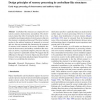99 search results - page 1 / 20 » Design principles of sensory processing in cerebellum-like s... |
BC
2008
13 years 5 months ago
2008
Cerebellum-like structures are compared for two sensory systems: electrosensory and auditory. The electrosensory lateral line lobe of mormyrid electric fish is reviewedandtheneural...
CDC
2009
IEEE
13 years 9 months ago
2009
IEEE
— We consider the problem of attitude stabilization using exclusively visual sensory input, and we look for a solution which can satisfy the constraints of a “bio-plausible” ...
AAAI
2007
13 years 7 months ago
2007
In this paper, we consider the exploration of topological environments by a robot with weak sensory capabilities. We assume only that the robot can recognize when it has reached a...
KNINVI
2005
Springer
13 years 10 months ago
2005
Springer
The timeworn claim that a picture is worth a thousand words is generally well-supported by empirical evidence, suggesting that diagrams and other information graphics can enhance h...
MIE
2008
13 years 6 months ago
2008
The Gene Regulation Ontology (GRO) is designed as a novel approach to model complex events that are part of the gene regulatory processes. We introduce the design requirements for ...

